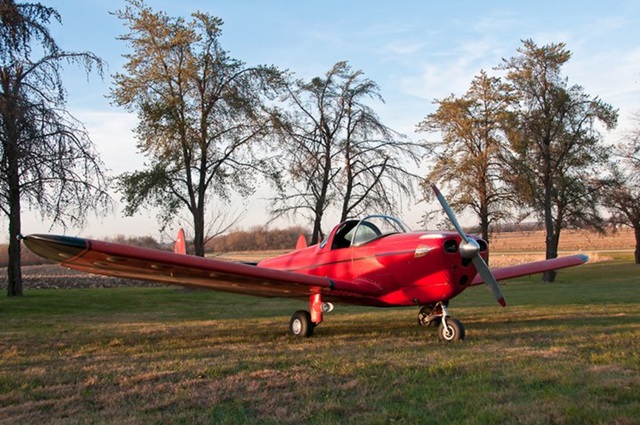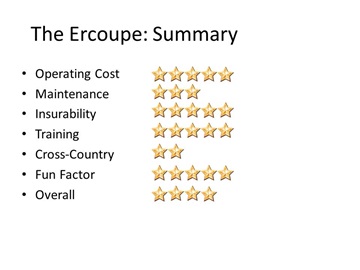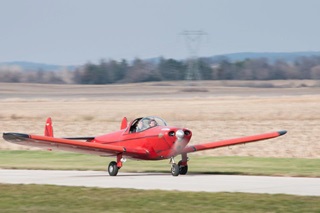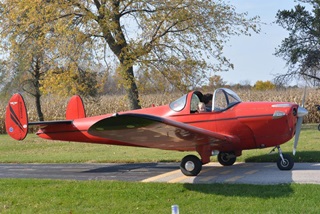 The Aircraft Spotlight feature looks at an airplane type and evaluates it across six areas of particular interest to flying clubs and their members: Operating Cost, Maintenance, Insurability, Training, Cross-Country, and Fun Factor.
The Aircraft Spotlight feature looks at an airplane type and evaluates it across six areas of particular interest to flying clubs and their members: Operating Cost, Maintenance, Insurability, Training, Cross-Country, and Fun Factor.
One look at an Ercoupe sitting on a ramp and it’s clear it’s not your typical airplane. It’s twin tails, bubble canopy and tricycle gear give it a look all its own. But it’s what you don’t see that makes it truly unique – no rudder pedals. The linked rudder and ailerons and stall proof characteristics were advancements far ahead of their time in 1937.
But you might not realize the Ercoupe was a trailblazer in another category – it could be considered the first certified-production tricycle-gear Light Sport Airplane.
When the Sport Pilot Certificate and Light Sport Category were created, Green Castle Aero Club in Oxford, Iowa, “decided right away that we wanted a tricycle-gear airplane to do that with and the only one that was out there that was certificated [at the time] was the Ercoupe,” said Terry Koehn, chief instructor for Green Castle. He tells us about their experience operating the cost-effective, easy-to-fly LSA with the twin-tails and bubble-canopy.
 Operating Cost (5 stars)
Operating Cost (5 stars)
The Ercoupe was designed by Fred Weick (who went on to design the Piper Cherokee) to be a spin-proof aircraft without rudder pedals. Making its first flight in 1937, it was the first production tricycle-gear aircraft. A few hundred were made before World War II and then several thousand between 1946 and 1948.
Powered by a four-cylinder Continental C-85, it has a common engine with a fuel burn of about 4 gph. That allows the Green Castle Aero Club to keep it on the line for just $75 an hour, Hobbs time wet. The purchase price for an Ercoupe runs anywhere from $17,000 to $30,000, making it comparable to a Cessna 150.
“We get good performance, low fuel burn,” Terry said. “It runs on about 4 gph and it runs almost as fast as a 150.”
Maintenance (3 stars)
The pros and cons of maintenance on an Ercoupe equal each other out. The good news is that it is a simple airplane without a lot of parts, and Terry said those parts are easy to get through Univair.
However, “you want somebody who is familiar with Ercoupe repairs,” Terry said. “I don’t think it’s a difficult airplane to work on, but you have to Ercoupe knowledge. There are some issues in the rigging that are important. Since the nose wheel, ailerons and rudder are all tied together, you want somebody who knows what they’re doing when it comes to an Ercoupe.”
The back elevator has a collar on it as part of the non-stall characteristics of the aircraft. However, “you can set it up so the airplane will stall,” Terry said. “Improper set up can make the airplane dangerous. That’s all part of having a mechanic who knows how to set the airplane up.”
The wings are fabric and the rest is metal, so it is best to keep an Ercoupe hangared. At some point the fabric will need to be replaced, but Terry thought the fabric would last at least 20 years if the plane is in a hangar and treated well.
Green Castle’s base annual cost about $950 and there is an AD that requires every 100 hours or three years the wings have to be removed for an interior inspection for corrosion, Terry said. That usually adds about $500 to the annual.
Insurability (5 stars)
Green Castle hasn’t had any problems getting insurance for the Ercoupe. With a relatively low hull value that is similar to the value of a C-150, the club pays the same price for a standard policy on the Ercoupe as they do for the C-150s in its fleet.
Training (5 stars)
Green Castle uses its Ercoupe as the primary training aircraft for Sport Pilot training. It’s a simple airplane with minimum instruments. Most new students don’t need much more than the required 20 hours for a Sport Pilot Certificate, and for private pilots who are transitioning into the Ercoupe, it takes about an hour or two of instruction, Terry said. One advantage is that the hourly rate is half the cost of renting a modern LSA, such as a CT or Skycatcher.
“It’s about as simple as an airplane can be. You don’t have to learn to taxi it,” Terry said. “Literally you drive it on the ground. It’s like driving an old Ford truck on an old road – no power steering and not much for shocks.”
It takes off easily and Terry said, “It’s easier to learn how to land than a Cessna.” However, the approach speed is generally a bit higher to eliminate the dangers of high sink rate on approach. The back elevator is set by collar and it only goes so far as part of the non-stalling feature of the airplane. If you get a little slow and the plane begins sinking, “if you don’t power out of it, you’ll run out of elevator and it will take you right to the ground. That’s why there are a lot of landing gear and prop strikes on the airplane, it is kind of notorious for that,” Terry said.
One other difference is the airplane doesn’t really stall. “You would think it’s stalling, the nose comes over quickly, but it never really stalls, it continues flying. And that’s why you don’t need the rudder pedals because there is no spin characteristic to it. Ailerons are still working,” Terry said.
Cross-Country Travel (3 stars)
Surprisingly, Terry said the Ercoupe “goes out a lot for cross countries. We have at least six pilots who take it regularly and they’re out probably three, four, five hours – out and back.”
It just won’t get you there very fast and you’ll need to pack light. The Ercoupe cruises at about 90 mph and holds 24 gallons of fuel, with nine gallons in each wing and six gallons in a fuselage header tank. The baggage capacity is limited to 65 pounds. All it has is “the space behind the seat and it is about 12-inches wide by the width of the cabin,” Terry said. “You could put a backpack back there, but leave the suitcase at home.”
Another drawback is the cabin is small. Two adults weighing about 180 pounds are likely to be shoulder to shoulder, and the seats don’t adjust. “It’s tighter than a 150,” Terry said. “It’s like getting in an MG, it’s pretty tight. It’s not made for large people.”
 Fun Factor (5 stars)
Fun Factor (5 stars)
“It’s right up there at number 6,” Terry said. “It’s quite maneuverable. It’s a very easy, fun, low and slow airplane. You can throttle back and putz around at 80 mph just like a Cub would. It’s a fun airplane.” And to top it off, the windows go down on both sides into the fuselage and you can fly with your arm out the window. Now who wouldn’t love that?
Overall (3 stars)
An Ercoupe is sure to attract a crowd wherever it lands. “The twin-tails give it away, it’s a unique airplane, and it’s getting recognized more and more,” Terry said. “It’s a popular airplane both for the private pilots and the Light Sport pilots.”
An Ercoupe can provide a club with a reliable vintage aircraft that meets the LSA requirements. It’s suitable for training new Sport Pilots or transitioning private pilots transitioning to Sport Pilot. And with a nose wheel, it’s easier to fly than a conventional gear aircraft. “Once you’ve flown one, or been in one, you’ll want to fly an Ercoupe because they are so easy to fly,” Terry said. “You drive them on the ground and drive them in the air.”